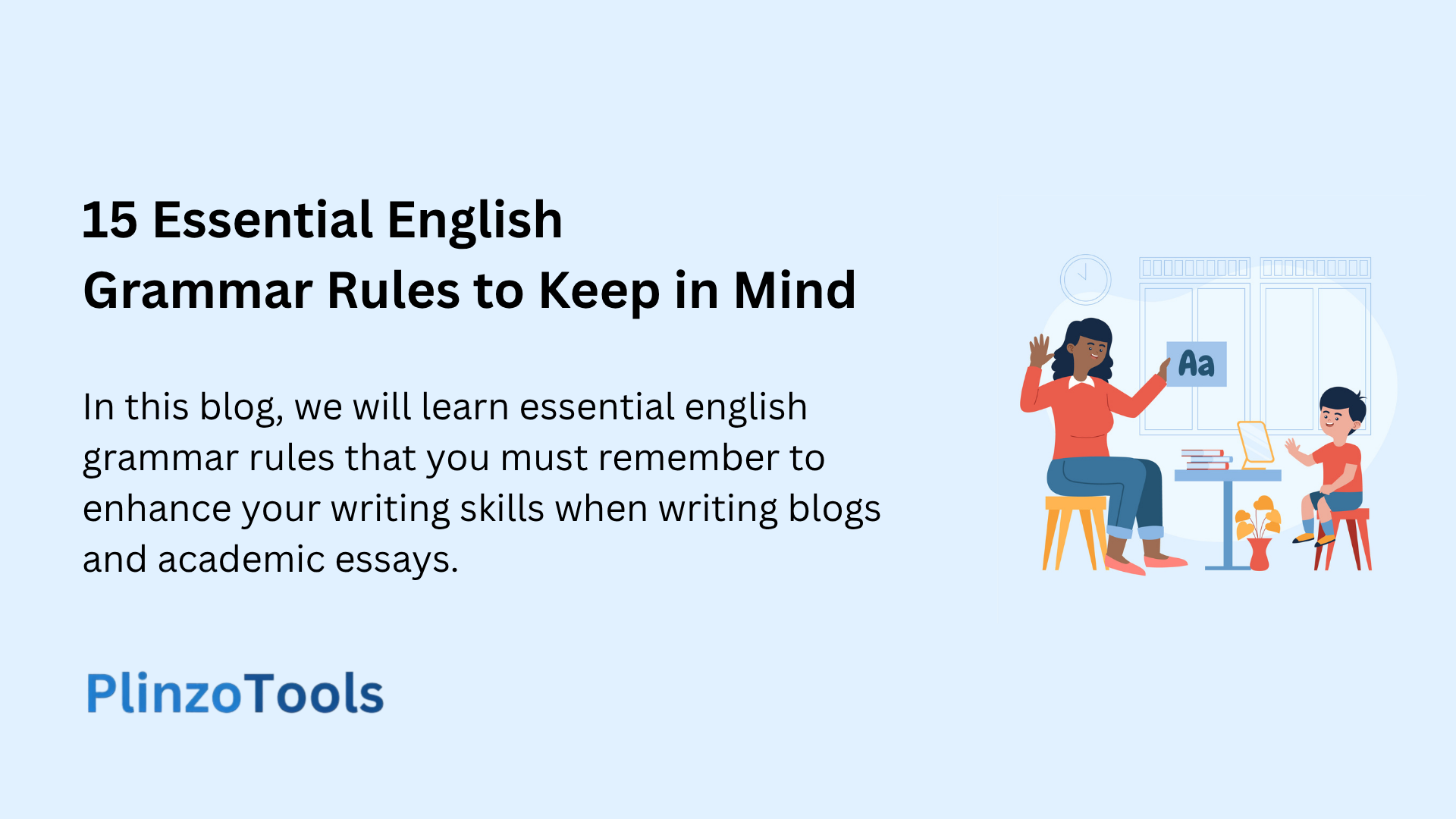
15 Essential English Grammar Rules to Keep in Mind

Mastering English grammar can feel overwhelming, but understanding fundamental grammar principles is crucial for effective communication. Whether you’re a native speaker looking to polish your writing skills or an English language learner building your foundation, these essential English grammar rules will transform your command of the language.
Grammar forms the backbone of clear, professional communication. From business emails to academic essays, proper grammar ensures your message reaches your audience without confusion or misinterpretation. According to Grammarly’s research, professionals with strong grammar skills are 70% more likely to advance in their careers.
For content creators and bloggers, mastering grammar is particularly important for effective blogging strategies that engage readers and improve search engine rankings. Let’s explore the most important grammar fundamentals that every English speaker should master.
Basic Rules of English Grammar
Understanding basic English grammar starts with recognizing patterns and structures that govern how we construct meaningful sentences. These foundational rules serve as building blocks for more advanced writing techniques and verbal communication skills. The Cambridge English organization emphasizes that consistent grammar practice significantly improves overall language proficiency.
1. Sentences Need a Subject and a Verb
Every complete sentence requires two essential components: a subject (who or what performs the action) and a verb (the action or state of being). This fundamental grammar rule ensures sentence completeness and clarity in communication.
| Wrong ✘ | Right ✔ |
|---|---|
| Sleeping on the couch. (Who’s sleeping?) | The cat is sleeping on the couch. |
| Running through the park. | The children are running through the park. |
| Beautiful flowers in the garden. | Beautiful flowers bloom in the garden. |
A sentence functions like a complete thought. Without both subject and verb, readers cannot understand who is doing what, leaving them confused about your intended meaning.
2. Word Order Matters
English follows a Subject-Verb-Object (SVO) sentence structure. This word order creates logical flow and prevents miscommunication. Disrupting this pattern can completely alter your sentence’s meaning or make it incomprehensible.
| Wrong ✘ | Right ✔ |
|---|---|
| Eats she apples. | She eats apples. |
| The book read I yesterday. | I read the book yesterday. |
| Football plays John every Sunday. | John plays football every Sunday. |
Proper word order ensures grammatical accuracy and helps readers follow your thoughts naturally. This syntactic structure is fundamental to English sentence construction.
3. Keep Tenses Consistent
Verb tenses indicate when actions occur—past, present, or future. Consistent tense usage prevents reader confusion and maintains logical chronological flow throughout your writing. Unnecessary tense shifts disrupt narrative coherence.
| Wrong ✘ | Right ✔ |
|---|---|
| He walked to school and buys lunch. | He walked to school and bought lunch. |
| She studies hard and passed her exam. | She studied hard and passed her exam. |
| They will arrive tomorrow and stayed for a week. | They will arrive tomorrow and stay for a week. |
Maintaining tense consistency demonstrates grammatical competence and ensures your temporal relationships remain clear for readers.
4. Use the Right Pronouns
Pronouns replace nouns to avoid repetition, but they must match their antecedents in number, gender, and case. Subject pronouns (I, he, she, they) perform actions, while object pronouns (me, him, her, them) receive actions.
| Wrong ✘ | Right ✔ |
|---|---|
| Her gave it to he. | She gave it to him. |
| Me and John went shopping. | John and I went shopping. |
| The teacher asked we students. | The teacher asked us students. |
Correct pronoun usage demonstrates grammatical precision and prevents ambiguity about who is performing or receiving actions in your sentences.
5. Apostrophes Have Rules
Apostrophes serve two primary functions: showing possession and forming contractions. They are never used for simple plurals. Understanding apostrophe rules prevents common punctuation errors that can make writing appear unprofessional.
| Usage | Example | Rule |
|---|---|---|
| Possession (Singular) | Sarah’s book | Add apostrophe + s |
| Possession (Plural ending in s) | Students’ books | Add apostrophe after s |
| Contraction | It’s raining | Replaces missing letters |
| Wrong (Plural) | Apple’s for sale ✘ | Never use for plurals |
Mastering apostrophe usage elevates your writing quality and demonstrates attention to grammatical detail.
6. Plural and Singular Forms Must Match
Subject-verb agreement requires singular subjects to pair with singular verbs, and plural subjects with plural verbs. This grammatical concordance ensures sentence harmony and prevents confusion about quantity.
| Wrong ✘ | Right ✔ |
|---|---|
| The team are playing well. | The team is playing well. |
| Five dogs runs in the park. | Five dogs run in the park. |
| Everyone have their opinions. | Everyone has their opinion. |
Subject-verb agreement is fundamental to grammatical correctness and demonstrates sophisticated language control.
7. There, Their, and They’re Aren’t the Same
These homophones sound identical but serve completely different grammatical functions. Confusing them creates communication errors that can undermine your credibility as a writer.
| Word | Meaning | Example |
|---|---|---|
| There | Location/existence | Look over there. There are cookies. |
| Their | Possession | Their house is beautiful. |
| They’re | Contraction (they are) | They’re coming to dinner. |
Distinguishing homophones demonstrates vocabulary precision and prevents embarrassing grammatical mistakes in professional writing.
8. Adjectives and Adverbs Do Different Jobs
Adjectives modify nouns and pronouns, while adverbs modify verbs, adjectives, or other adverbs. Understanding these parts of speech ensures accurate description and proper sentence construction.
| Part of Speech | Function | Example |
|---|---|---|
| Adjective | Describes nouns | She is a quick runner. |
| Adverb | Describes verbs | She runs quickly. |
| Adverb | Describes adjectives | She is extremely quick. |
Using appropriate modifiers enhances writing precision and demonstrates grammatical sophistication.
9. Commas Prevent Confusion
Commas separate ideas, list items, and clauses to improve readability. Strategic comma placement prevents misinterpretation and creates natural reading rhythm. However, comma overuse can disrupt sentence flow. Interestingly, mastering punctuation marks like commas can be as subtle as understanding invisible characters in text formatting, which also affects document presentation.
| Usage | Wrong ✘ | Right ✔ |
|---|---|---|
| Before conjunctions | I wanted to go but, I was tired. | I wanted to go, but I was tired. |
| In series | Apples bananas and grapes | Apples, bananas, and grapes |
| After introductory phrases | After the movie we went home. | After the movie, we went home. |
Proper comma usage demonstrates punctuation mastery and ensures clear communication flow.
10. Don’t Overuse Capital Letters
Capitalization follows specific rules: capitalize proper nouns (names, places, days), sentence beginnings, and titles. Random capitalization appears unprofessional and distracts readers from your content.
| Wrong ✘ | Right ✔ |
|---|---|
| I Met lisa On monday. | I met Lisa on Monday. |
| My Favorite BOOK is great. | My favorite book is great. |
| THE weather IS nice TODAY. | The weather is nice today. |
Appropriate capitalization demonstrates writing professionalism and grammatical awareness.
11. Prepositions Show Relationships
Prepositions connect nouns, pronouns, and phrases to other sentence elements, showing spatial, temporal, or logical relationships. Choosing correct prepositions ensures precise meaning and prevents confusion.
| Wrong ✘ | Right ✔ |
|---|---|
| The book is in the table. | The book is on the table. |
| I’m good in mathematics. | I’m good at mathematics. |
| We’ll meet on 3 o’clock. | We’ll meet at 3 o’clock. |
Mastering prepositional usage demonstrates nuanced language understanding and prevents common ESL errors.
12. Articles (A, An, The) Aren’t Optional
Articles define nouns as specific or general. “A” and “an” introduce indefinite nouns, while “the” specifies particular items. Article usage significantly affects sentence meaning and grammatical accuracy. According to English Grammar 101, article errors are among the most common mistakes made by English learners.
| Usage | Example | Rule |
|---|---|---|
| Indefinite (consonant sound) | A banana, a university | Use “a” |
| Indefinite (vowel sound) | An apple, an hour | Use “an” |
| Definite (specific) | The cat we saw | Use “the” |
| Wrong | I saw cat. ✘ | Always use articles |
Proper article usage demonstrates grammatical competence and prevents awkward-sounding sentences.
13. Double Negatives Change Meaning
Double negatives create positive meanings, often unintentionally. Using two negative words cancels them out mathematically, reversing your intended message and confusing readers.
| Wrong ✘ | Right ✔ | Actual Meaning |
|---|---|---|
| I don’t need no help. | I don’t need help. | I DO need help (unintended) |
| She can’t find nothing. | She can’t find anything. | She CAN find something |
| We don’t have no time. | We don’t have time. | We DO have time |
Avoiding double negatives ensures clear communication and prevents embarrassing meaning reversals.
14. Sentences Shouldn’t Run Forever
Run-on sentences occur when independent clauses join without proper punctuation or conjunctions. These lengthy constructions confuse readers and demonstrate poor sentence control.
| Wrong ✘ | Right ✔ |
|---|---|
| I went to the store I bought milk it was raining outside. | I went to the store. I bought milk. It was raining outside. |
| She loves reading books she visits the library frequently she recommends titles to friends. | She loves reading books. She visits the library frequently and recommends titles to friends. |
Breaking complex thoughts into manageable sentences improves readability and demonstrates writing sophistication.
15. Punctuation Changes Meaning
Punctuation marks dramatically affect sentence interpretation. Misplaced or missing punctuation can completely alter your intended message, sometimes with humorous or alarming results.
| Punctuation Error | Meaning Change |
|---|---|
| Let’s eat Grandma! | Cannibalistic invitation |
| Let’s eat, Grandma! | Dinner invitation to grandmother |
| A woman without her man is nothing. | Sexist interpretation |
| A woman: without her, man is nothing. | Empowering interpretation |
Strategic punctuation usage ensures accurate communication and prevents unintended interpretations.
Final Thoughts
Mastering these essential English grammar rules provides the foundation for effective communication in both written and spoken contexts. Grammar proficiency enhances your professional credibility, academic success, and personal expression capabilities. Research from Purdue University’s Online Writing Lab shows that strong grammar skills directly correlate with improved writing confidence and clarity.
Remember that grammar improvement requires consistent practice and patience. Start by focusing on one or two rules that challenge you most, then gradually incorporate others into your daily writing routine. Reading extensively also reinforces proper grammar patterns naturally. Consider exploring educational apps for adults that offer interactive grammar exercises and personalized learning experiences.
Whether you’re preparing for standardized tests, advancing your career, or simply wanting to communicate more effectively, these fundamental grammar principles will serve you well. Strong grammar skills open doors to better opportunities and ensure your ideas reach others clearly and persuasively. The British Council offers excellent supplementary resources for continued grammar development.
Invest time in grammar mastery—it’s one of the most valuable skills you can develop for lifelong communication success. Your future self will thank you for building this solid grammatical foundation.
You can also check PlinzoTools for more useful online tools for your daily work. They are all secure and free-to-use utilities. So, do give them a try!































